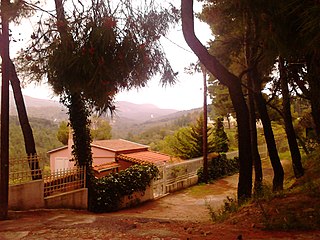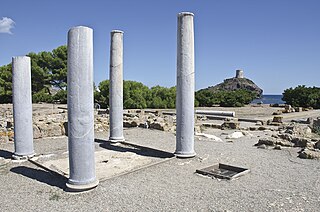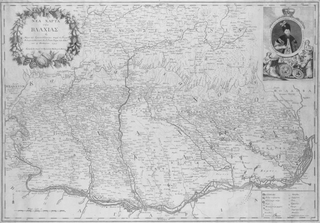
The League of Corinth, also referred to as the Hellenic League, was a federation of Greek states created by Philip II in 338–337 BC. The League was created in order to unify Greek military forces under Macedonian leadership (hegemony) in their combined conquest of the Persian Achaemenid Empire.

Acharnae or Acharnai was a deme of ancient Athens. It was part of the phyle Oineis.

Nora is an ancient pre-Roman and Roman town on a peninsula near Pula, near to Cagliari in Sardinia.

Papyrus 100, designated by siglum 𝔓100, is an early copy of the New Testament in Greek. It is a papyrus manuscript of the Epistle of James. The surviving texts of James are verses 3:13-4:4; 4:9-5:1, they are in a fragmentary condition. The manuscript has been assigned paleographically to the late 3rd century, or early 4th century.
The Epistula ad Carpianum or Letter of Eusebius is the title traditionally given to a letter from Eusebius of Caesarea to a Christian named Carpianus. In this letter, Eusebius explains his ingenious system of gospel harmony, the Eusebian Canons (tables) that divide the four canonical gospels, and describes their purpose, ten in number.
The Claremont Profile Method is a method for classifying ancient manuscripts of the Bible. It was elaborated by Ernest Cadman Colwell and his students. Professor Frederik Wisse attempted to establish an accurate and rapid procedure for the classification of the manuscript evidence of any ancient text with large manuscript attestation, and to present an adequate basis for the selection of balanced representatives of the whole tradition. The work of Wisse is limited only to three chapters in Luke: 1, 10, and 20.
Panayotis Koupitoris was a writer from the island of Hydra.
Anastasios Orlandos was a Greek architect and historian of architecture.
Asclepius is the sixth tragedy of Angelos Sikelianos and the only one that was unfinished. It was partially written between 1915 and the end of the poet's life in 1951. It was published in 1955.

The Pamphlet of Rigas Feraios is a large chalcography printed in Vienna in 1797 by Rigas Feraios. It depicts a portrait of Alexander the Great framed by war scenes and portraits of his generals. The etching was incised by François Müller, who cooperated with Rigas for his cartographic work which he published the same year: Rigas' Map of Greece (1797), the New Map of Wallachia and part of Transylvania (1797) and the General Map of Moldavia (1797). It was released in 1200 copies from the printing press of Nitsch. One of the two copies that have been discovered in Greece is displayed in the National Historical Museum of Greece.
Pieros Voidis Mavromichalis was a military leader of the Greek Revolution of 1821. He was born in Mavrovouni of Mani and he was killed in action on 20 May 1825, during the battle of Maniaki between Greek revolutionaries and the Egyptian forces of Ibrahim Pasha.
Georgios Psyllas was a Greek scholar and politician, and editor during the Greek War of Independence of the newspaper Efimeris ton Athinon.

The General Map of Moldavia is one of the two maps of the Danubian Principalities which was printed by Rigas Feraios in 1797, the other being the New Map of Wallachia. He printed it in Jacob Nits’ printing press and the engraving was made by Franz Müller. The map is of 82 x 63 cm. in black and white and it is printed on paper from Holland. Its full title is "GENERAL MAP / OF / MOLDAVIA,/ AND PART OF ITS NEIGHBOR PROVINCES/. Published by Rigas Velestinlis from Thessaly for the sake of Greeks and philhellenes, 1797. Engraved by Francois Müller in Vienna".

The New Map of Wallachia is one of the maps of the Danubian Principalities which were printed by Rigas Feraios in 1797 in Vienna, engraved by Franz Müller who was also Rigas' partner in other cartographic works. The other is the General Map of Moldavia. The Map is in black and white, it is 0,85 x 0,63 m. and has the title New Map of Wallachia and part of Transylvania by Rigas Velestinlis from Thessaly, published for the sake of the Greeks and philhellenes – 1797-engraved by Franz Müller in Vienna.

The celebration of the Greek Revolution of 1821, less commonly known as Independence Day, takes place in Greece, Cyprus and Greek diaspora centers on 25 March every year, coinciding with the Feast of the Annunciation.
The Epidaurus Festival, also known as the Epidávria, is an ancient theatre festival held every year during the summer months in the ancient theatre of Epidaurus, on the archaeological site of the Asclepion. It is organised as part of the Athens-Epidaurus Festival. It includes performances of tragedies by Aeschylus, Sophocles and Euripides, as well as surviving comedies by Aristophanes. Some performances consist simply of revivals of ancient myths or contemporary plays written on the basis of ancient dramas.
Simos Menardos was a Greek and Cypriot academic, writer, philologist, folklorist, poet, lector in Mediaeval and Modern Greek at the University of Oxford, professor of Ancient Greek Philology and later rector of the University of Athens and member of the Academy of Athens and Parnassos Literary Society.
Georgios Sotiriou or Soteriou he was a Byzantinist, archaeologist, curator and later head of the Byzantine and Christian Museum in Athens.
Vasilis Papavasileiou is a Greek theatre director, actor, writer and translator. He served as artistic director of the National Theatre of Northern Greece from 1994 to 1998.
Konstantinos Spyridakis was a Greek Cypriot politician, educator, scholar and writer, who served as the first minister of Education of the Republic of Cyprus (1965–1970). After studying history, philosophy, and philology in Athens and Berlin, he worked as a teacher, becoming headmaster of Pancyprian Gymnasium (1936–1960). His community and political roles included membership of the Ethnarchical Council and advisor to the Cyprus Ethnarchy Office (1948–1960), and president of the Greek Communal Chamber of Cyprus (1960–1965).









